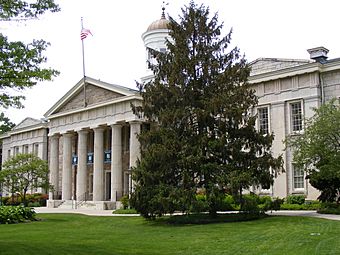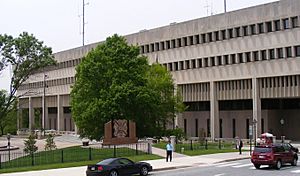Baltimore County Circuit Courthouses facts for kids
Quick facts for kids |
|
|
Baltimore County Courthouse
|
|

Courthouse from northeast
|
|
| Location | Washington Avenue between Pennsylvania and Chesapeake Avenues, in Towson, Maryland |
|---|---|
| Area | 4 acres (1.6 ha) |
| Built | 1855 (additions: 1910, 1925, 1958) |
| Architect | Dixon, Bilbirnie & Dixon; E.F. Baldwin, Josias Pennington, Baldwin & Pennington |
| Architectural style | Greek Revival |
| NRHP reference No. | 72000569 |
| Added to NRHP | October 27, 1972 |
The Baltimore County Courthouses are important buildings in Towson, Maryland. Towson is the main town, or "county seat," for Baltimore County. There are two main buildings. The older one, called the "Historic Courthouse," was built between 1854 and 1856. It holds many offices for the county government, like the County Executive and the County Council.
Next to it, separated by a plaza, is the "County Courts Building." This newer building was finished in 1971. It's where important court cases happen for Baltimore County. It also houses the Baltimore County Sheriff's Office, which helps keep the courthouse safe.
Contents
The Historic Courthouse: A Look Back
The historic Baltimore County Courthouse is a beautiful building made of limestone and marble. It has two floors and a grand look. Around it, there's a nice park with flowers, trees, and benches. You can also find small memorials there. The front of the building, built in 1855, looks like Greek Revival architecture. It has a large porch with columns and a pointed roof section called a pediment.
The building is about 112 feet long and 56 feet deep. On top, there's a small, decorative tower called a cupola with a copper roof. This courthouse was built for about $30,000 back in 1854-55. It's one of the few buildings in Maryland shaped like an "H" that still looks mostly the same as when it was built.
Why Towson Became the County Seat
Before Towson, the county seat for Baltimore County was in Baltimore Town (later Baltimore City). The first shared courthouse for the city and county was built in 1768. Before that, the county seat was in a village called Joppa, Maryland. When the court moved, Joppa became much less important.
The second city/county courthouse in Baltimore was built in 1768. It was near a public square that later became famous. This square was considered for a monument to George Washington, the first U.S. President. However, people worried the tall monument would be too close to their homes. So, the Washington Monument was built further north in Baltimore.
The old courthouse square became a place for public gatherings. After the War of 1812, it was renamed Battle Monument Square. This honored soldiers from the Battle of North Point and the bombardment of Fort McHenry. The second courthouse faced this square.
The Star-Spangled Banner Connection
During the War of 1812, a lawyer named Francis Scott Key saw the British attack Fort McHenry. He was on a ship and watched the battle. Seeing the American flag still flying after the attack inspired him to write a poem. This poem, "The Defence of Fort McHenry," later became "The Star-Spangled Banner" and is now the National Anthem of the United States. This famous event happened near the area where the old Baltimore courthouses were located.
Moving the County Seat to Towson
For many years, people discussed moving the county seat. In 1851, Baltimore City officially became an "independent city." This meant it was separate from Baltimore County, like its own county. So, Baltimore County needed a new county seat.
After votes and discussions, citizens of Baltimore County decided to move the county seat to "Towsontown." This happened on February 13, 1854.
The Towson Family and the Town
Towson was named after the Towson family, who settled there in the 1750s. Brothers William and Thomas Towson were early farmers. Thomas's son, Ezekiel Towson, built a tavern. This tavern became a popular stop for travelers and farmers. It helped the small crossroads community grow into a business center.
A famous member of the family was General Nathan Towson, a hero of the War of 1812. His reputation helped make the town well-known in the early 1800s.
Building the New Courthouse in Towson
The first stone for the new Towson courthouse was laid on October 19, 1854. Many people gathered for the ceremony. A local lawyer, Coleman Yellott, gave a speech. He hoped the building would stand for ages as "a temple of Justice!"
The courthouse was designed by well-known architects, including Dixon, Bilbirnie & Dixon and Baldwin & Pennington. It was finished in 1855. However, the first court session didn't happen until January 5, 1857. This was because of a long legal issue about the land.
In 1861, during the American Civil War, someone tried to burn down the building. Luckily, the fire was mostly contained to the records office. The courthouse was made bigger in 1910, 1925, and 1958. It was added to the National Register of Historic Places in 1972, recognizing its historical importance.
The County Courts Building: Modern Justice
The Baltimore County Courts Building is located on Bosley Avenue in Towson. It faces the same public square as the historic courthouse. People sometimes call it the "New Courthouse." It was built around 1970 in a modern style. It has white stone panels that match the older building's look.
This building is where the 17 judges of the Circuit Court of Maryland for Baltimore County work. It also houses the offices for the Baltimore County State's Attorney and many support staff. Other, smaller courts for less serious legal matters are located in different parts of Baltimore County.
- Baltimore County Courthouse, Baltimore County, including photo from 1989, at Maryland Historical Trust
Images for kids






